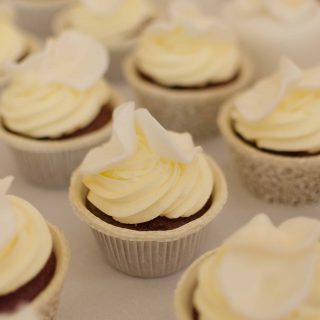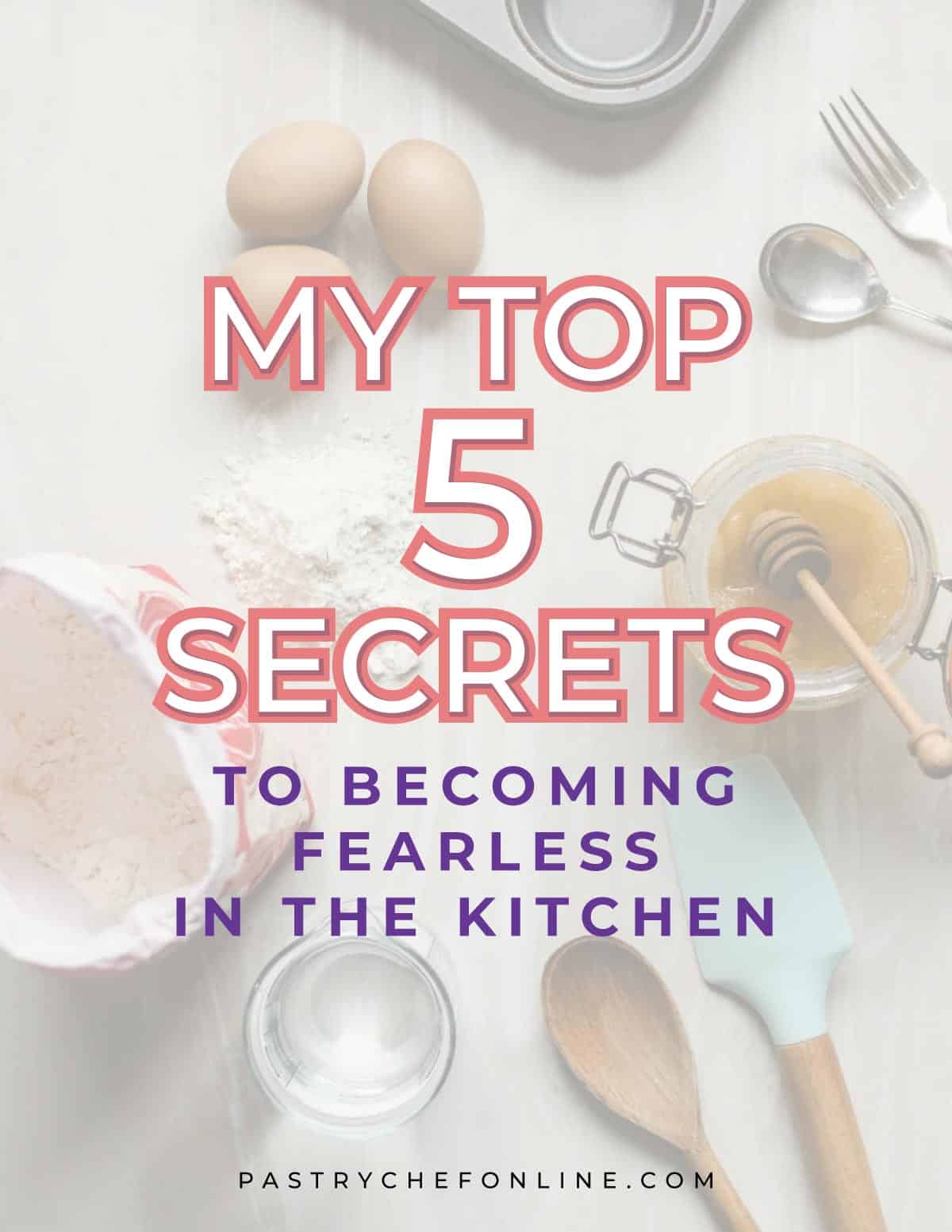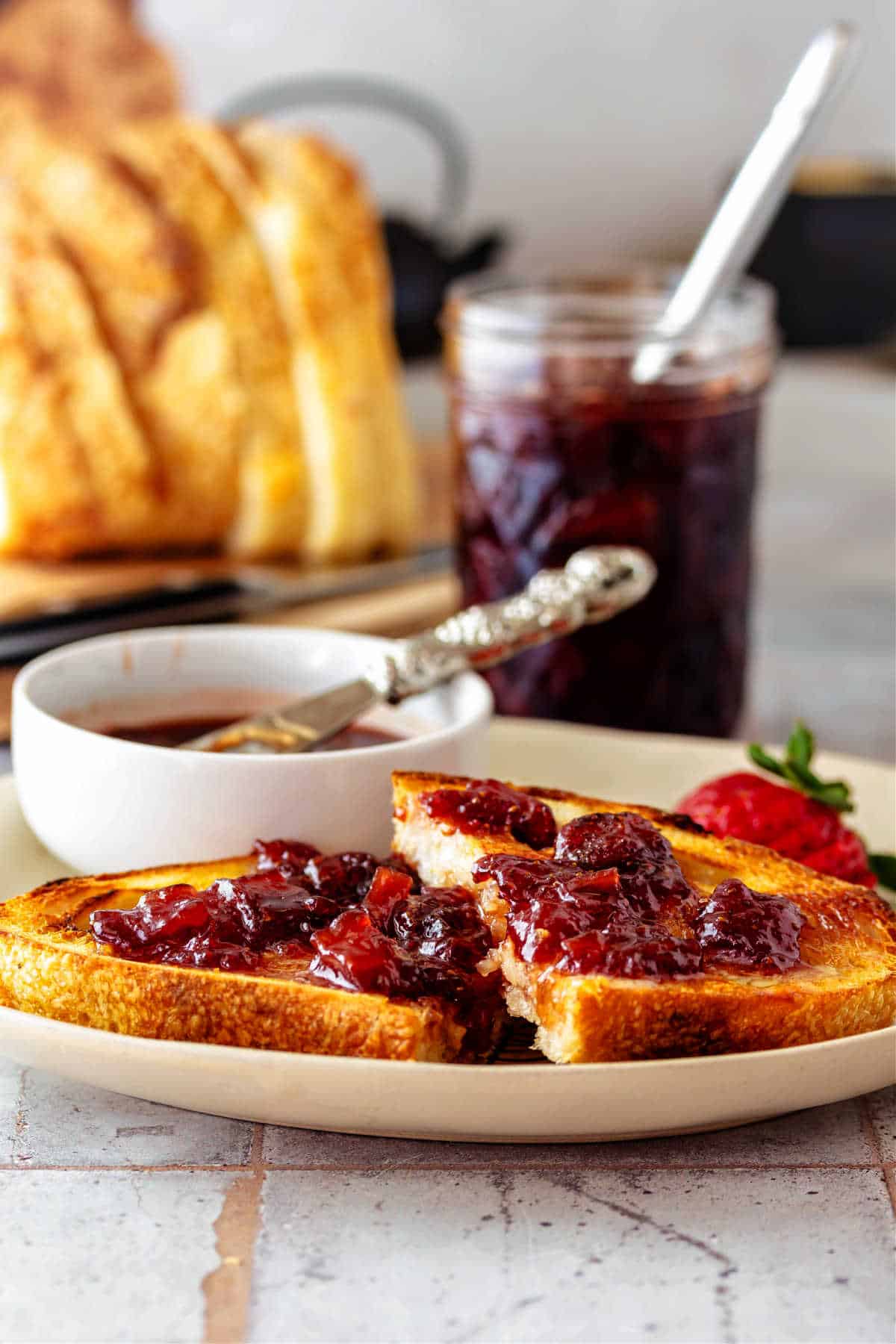This is my favorite frosting, and it can be flavored in countless ways.
Some people don’t like the full-on flavor of butter in this frosting.
Some don’t like how rich it is.
Pastry Chef Online Participates in Affiliate Programs. If you make a purchase through one of my links, I may earn a small commission. For more information click to read my disclosure policy
Some don’t like the eggs.
I feel sorry for these people.
Would you like to save this post?

French Buttercream
Recipe for traditional French Buttercream--silky smooth and rich
Tried this recipe?Please give it a star rating!
Would you like to save this post?
Ingredients
- 12 oz . sugar
- 3 oz . water
- 4.5 oz . egg yolks
- 15 oz . softened butter--around 68F
- pinch of salt
- 1 ½ teaspoon vanilla
Instructions
- Bring the sugar and water to a boil in a small saucepan.
- Cover with a lid or plastic wrap and let boil for 2-3 minutes. Remove the lid and cook the sugar to 240F.
- While your syrup is boiling, whip the yolks and salt on high speed until very light and thick and tripled in volume.
- When the syrup has reached temperature, turn down the mixer speed and slowly but steadily pour the syrup in a thin stream down the inside of the mixer bowl.
- ***Make sure the syrup is sliding down the inside of the bowl--this will help to cool it off a little before it reaches the eggs. It will also keep molten sugar from splattering all over the inside of your mixer instead of ending up where it belongs: in the buttercream.
- Increase speed to high and whip until cool.
- Whip in the butter a little at a time. Don't add it too quickly. Wait until what you've put in has been completely blended in before you add some more.
- Beat in the vanilla.
Did You Make Any Changes?
Notes
You can pretty much add any extract or liqueur to taste. To make chocolate buttercream, whisk in 6 oz. melted and cooled bittersweet chocolate. For a fruit flavored buttercream, whisk in 4-6 oz. fruit puree. To make caramel buttercream, cook the sugar syrup to a medium amber caramel before adding it to the eggs.
Did you make this recipe?Please tell us what you loved!



Join in Today!
So I have dreams of making strawberry macarons this weekend.
Strawberry powder/freeze dried strawberries can be difficult and expensive to get where I am, but jam isn’t so I’m thinking about only using powder in the shells and jam to make the buttercream.
You say 4-6oz for a fruit puree. Would you use the same weight for jam or do you have a different recommendation?
Hi, Marcus. If you use jam, which is much sweeter than puree, you’ll want to cut back on the sugar by about the same amount as there is sugar in the jam. Check the jam label, and calculate the grams of sugar in 4 (or 6) oz, and then decrease the sugar in the recipe by the same amount. That way, you’ll have a nicely balanced buttercream that is not too sweet. Also, if the color is important to you, know you’ll probably have to add a drop or two of red or pink food coloring to enhance the strawberry “look.” Happy macaron-ing!
How can I make Salted Caramel Flavoured French Buttercream?
Hi, Angie! I’ll refer you to this recipe for burnt caramel buttercream: https://pastrychefonline.com/stout-cake-and-burnt-caramel-buttercream/ Don’t take the sugar as dark as possible as in this recipe. Take it off the heat at a lovely deep amber color. Then add enough salt–a little at a time and tasting as you go–until you like the balance: https://pastrychefonline.com/stout-cake-and-burnt-caramel-buttercream/ It will be as rich as rich can be! An alternative is to make the standard French buttercream, leaving out just a bit of the sugar from the original recipe and then adding in maybe 1/2 cup of salted caramel sauce once you’ve whipped in all the butter. Enjoy!
Jenni — I had a request from a cake-loving client this week to make her one of those ombre rose decorated layer cakes that had a big internet moment a while back. (Images & methods abound on YouTube.) Now, I’m basically a tart & pie person and have an aversion to fussily or baroquely decorated cakes — and I especially dislike American bakery buttercreams and fondant icings. It was your variety of flavorful pound and rustic cakes that originally drew me to your blog, to elevate my cake knowledge.
But I thought I could manage one of these girly-girl cakes using this French buttercream, although my inner voice was telling me I should use the Simple Buttercream you recommend as better for hot weather durability. I’m in hot, humid South Carolina and it is July, after all.
This French buttercream was delicious, and dead simple, too. (I’m itching to try the caramel variation you list in the notes.) But when piped, the edges of my roses weren’t crisp/sharp enough to give a good visual effect. They weren’t ugly, and the cake looked decent, but I just would’ve liked more distinctive edges.
So I guess my questions are: Is that just the nature of this buttercream? Do you have success piping it? And would I have been wiser to use the Simple/American style and sacrifice some flavor for style?
What temp was your frosting? If you are lucky and can manipulate the temperature, you should be able to get fairly crisp edges, although if they get warmer, since they’ll be so thin, they’ll melt pretty quickly. I’d shoot for piping the frosting at about 68F (the frosting, not the room). My vote is to always err on the side of keeping flavor, but maybe for a schmancy party, a little frilly isn’t completely a bad thing. You could always try (and I hesitate to say this) using about 1/4 shortening for 1/4 of the butter in the buttercream. It may help it to hold better edges across a wider range of temperatures, even if you’ll be sacrificing just a bit of flavor.
Thanks, Jenni! I did try to keep it cool, using your bag o’ frozen veg technique, so I don’t *think* that was a problem. But I have another piped cake to make this week, and I think I’m going to try your suggestion of a a bit of shortening. I have a some of that decent Spectrum organic shortening that holds it shape real well at room temp, so maybe that’ll help. And I don’t think the audience I’m cooking for will be as picky as me about the taste — they eat a lot of regular bakery cakes that taste to me like Crisco and sugar.
But this French buttercream is going to become a standard for me… I really love the richness that the egg yolks give it, can’t wait to see how it is with the syrup caramelized.
Thanks again for being your usual helpful self!
Do let me know how it turns out, and rest assured that we are our own worst critics! Everyone will love it, I’m sure!
my buttercteam is not stiff enough. what should i do?
Most likely it’s a temperature issue, unless you didn’t heat the sugar to a high enough temperature. Refrigerate for about 20 minutes and rebeat. I often just grab a couple of bags of frozen peas (or other tiny frozen vegetables) and rub them on the outside of the mixer bowl while the mixer is running. In a few minutes. the buttercream has usually stiffened up enough to make it perfect for covering and piping. Hope that helps. 🙂
Question about the butter, regular salted butter or is unsalted butter better?
Unsalted is better for a couple of reasons. First, you can add only the amount of salt you want w/o having it dictated by the butter makers and second (and more importantly) since salt is a preservative, salted butter is usually older and contains more liquid than unsalted, which goes rancid more quickly and so has to be put on the shelves in a timely manner. If you have a choice, go w/unsalted for freshness’s sake. 🙂
I read something in an Italian buttercream recipe that if you pour the sugar syrup on the sides of a bowl, it will crystallize and won’t be a syrup anymore. Does this happen to you? Or do you use a glass bowl instead of metal? Not super familiar with buttercream at all so I find it interesting 🙂
As long as there are no other sugar crystals on the sides of the mixing bowl (and there shouldn’t be since all the sugar should be in your syrup), you’ll be fine. I’ve never had that happen to me. What *has* happened before is when I forget and don’t pour in a thin stream down the side of the bowl but rather just try to stream it in. Then the whisk attachment shoots the sugar mostly onto the sides of the bowl where it solidifies and doesn’t actually get beaten into the meringue. That is a mess! I hope this is helpful, and thanks for the question.
Wow! This was delicious! I used this on two separate cakes for my son and mom. My son’s I used under fondant and it help up great! Everyone wanted extra pieces! Thanks for sharing this recipe, it will be my go-to!
Fantastic! I’m so glad you enjoyed it:)
Fantastic! I’m so glad you enjoyed it:)
What size cake will this cover? For the egg yolks approx how many eggs is that? How many cups of sugar? Is this butter approx 4 sticks?
Thank you!
I hesitate to give volumetric measurements because I believe you get the most accurate results using a scale. Having said that, in the US sticks of butter generally weigh 4 oz each, a cup of sugar weighs in at approximately 7 ounces, and a yolk weighs about .5-.6 ounces. For this formula, you’re looking at roughly 2 scant cups of sugar, 3 3/4 sticks of butter and maybe 9 yolks, depending on their size. See what I mean about weighing being more precise? 😉 This is more than sufficient to fill and frost a 9″ layer cake. Leftovers refrigerate well for about a week and freeze for up to 3 months. Just make sure it comes completely up to cool room temperature before rewhipping to “fluff up” the frosting and get it to a nice, spreadable consistency. If you start whipping it before it is back up to temperature, it’ll get kind of curdly like cottage cheese.
That is very helpful! I can’t wait to try this recipe, I will post how me and family enjoyed it next week.Thank you so much for the quick response, I apologize for not responding earlier, I thought I did but guess I didn’t post it.
Yes, sometimes the commenting systems can be a bit…finicky! I hope you enjoy it; looking forward to your review:)
It’s very similar to a French buttercream recipe I use, so I’m sure it’s lovely, but I have one question about the directions: do you REALLY use plastic wrap to cover a boiling pot of sugar water as you say in Step 2?
I really do! It works like a charm! Makes a tight seal if you need it or cut whatever size vent hole you need. It’s one of the two useful pieces of information Iearned in culinary school. The other also has to do w/plastic wrap: it can go in the oven and is perfect for linking dough for blind baking. As long as it doesn’t touch the metal, it won’t melt. Plastic wrap is magical!
This was good frosting considering I had never made a buttercream like this before 🙂 thanks for the recipe!
I’m so glad you enjoyed it! French buttercream is rich and decadent and one of my favorite frostings:)